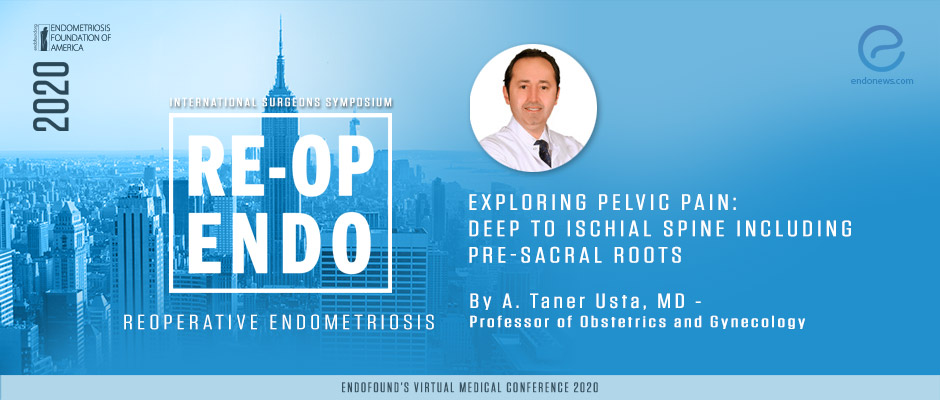Exploring Pelvic Pain: Deep to Ischial Spine Including Pre-Sacral Roots - A. Taner Usta, MD
Jan 5, 2021
Chronic pelvic pain is defined as pain in the pelvic area that lasts for 6 months or longer and results in functional or psychological disability or requires intervention and treatment by the American College of Obstetrics and Gynecologists. There are…
Key Points
Information for the presentation: Taner Usta, MD is a professor in the Endometriosis and Chronic Pelvic Pain Center, Department of Obstetrics and Gynecology, Acıbadem Altunizade Hospital, University of Acıbadem Mehmet Ali Aydınlar, Istanbul, Turkey. He is the president of the Turkish Endometriosis and Adenomyosis Society. His speech in Endofound 2020 is on the topic "Exploring pelvic pain: Deep to Ischial Spine Including Presacral Roots"
Importance:
- Vascular entrapment of pelvic nerves is a rare but important cause of chronic pelvic pain.
- Considering that pelvis is an anatomically complex area, the diagnosis, and treatment of entrapment of pelvic nerves are not easy.
Highlights:
- The most important part of the management of vascular entrapment of pelvic nerves is the preoperative evaluation in terms of determining the indication for surgery and orienting the dissection only on the involved nerves.
Remarks:
- The knowledge of the diagnosis and treatment of chronic pelvic pain is better today.
- The most important step in the diagnosis of vascular entrapment of pelvic nerves is the recognition of the pelvic origin of the symptoms.
- First preoperative neuro-pelveological diagnosis and then laparoscopic exploration of the possible compressed nerves are important.
- Complete remission of pain is observed in only half of the patients, despite the high cure and improvement rate.
- In the presence of sciatica, gluteal, or perineal pain without any spinal or deep gluteal causes, it must be kept in mind that intrapelvic portions may be entrapped, especially in the presence of urinary symptoms.
- Adhesions may be the cause of chronic pelvic pain, especially in the presence of previous abdominal operations or infections.
- The differential diagnosis also includes retroperitoneal pathologies.
Lay Summary
Chronic pelvic pain is defined as pain in the pelvic area that lasts for 6 months or longer and results in functional or psychological disability or requires intervention and treatment by the American College of Obstetrics and Gynecologists. There are many etiological factors of pelvic pain related to pelvic nerves including blunt trauma, surgery, obstetrical, endometriosis, vascular nerve entrapment, and fibrosis.
In his speech in Endofound 2020, Dr. Taner Usta, MD, a professor in the Department of Obstetrics and Gynecology at the University of Mehmet Ali Aydınlar Acıbadem, Istanbul-Turkey, focused on three of the etiological factors of pelvic pain related to pelvic nerves: vascular nerve entrapment, endometriosis, and adhesions/fibrosis.
Vascular entrapment of pelvic nerves is a special form of pelvic congestion which is a well-known cause of pelvic pain. The mechanism of the pain is explained by the nerve compression between the vessels or between a fixed anatomical structure (ligament, bone, fascia, and muscle) and damage to the epineurium in the pelvis which is a very complex area. The main symptoms are sciatica with urinary manifestations, refractory pelvic and perineal pain, and gluteal pain associated with perineal, vaginal, or penile pain. The symptoms are unilateral. It is important to question the patient about pelvic, urinary, or bowel problems since they show the presence of sacral autonomic nerve damage, according to Dr. Usta.
“Pudendal neuralgia, caused by the involvement of the pudendal nerve which originates from the S2, S3, and S4 sacral nerve roots, is a good example of the symptoms of intrapelvic nerve entrapment syndrome” Dr. Usta stated. “The patients have pain on the affected side, urinary problems, constipation, and foreign body sensation in the rectum, which is a symptom that the patients don’t tell spontaneously.”
During his presentation, Dr. Usta showed the videos of the laparoscopic management of the vascular entrapment of sacral nerve roots in three cases with chronic pelvic pain. One of his videos was from his case report was the first presentation of robot‐assisted laparoscopic management of a vascular entrapment of the sacral nerve root.
Although rare, endometriosis can also infiltrate the sacral nerve roots. Dr. Usta showed a video of a successful laparoscopic excision of a deep endometriotic nodule located on the sacral nerve root in a 38-year old woman in whom significant pain relief was observed postoperatively.
“Especially in the presence of previous abdominal surgeries, infections, and inflammation, pelvic adhesions should be brought to mind.”, Dr. Usta told. However, there is still a lack of knowledge of intraabdominal or retroperitoneal adhesions/fibrosis, according to him. “Moreover, whether adhesion causes chronic pelvic pain or whether the surgery is indicated is still debated. Physical examination and imaging methods might not help to identify intraabdominal adhesions.”
In addition, Dr. Usta presented interesting two patients with ongoing chronic pelvic pain despite several surgeries and showed robot-assisted laparoscopic management of their intraabdominal and retroperitoneal fibrosis which provided significant pain reduction. One of them also had pelvic endometriosis. He also mentioned the use of nerve blocks for the relief of pain in pudendal neuralgia.
Research Source: https://www.endofound.org/exploring-pelvic-pain-deep-to-ischial-spine-including-pre-sacral-roots-taner-usta-md?pop=mc
Chronic pelvic pain endometriosis quality of life gynecology spoonie fibrosis nerve entrapment pudendal neuralgia neuralgia adhesion mc2020

